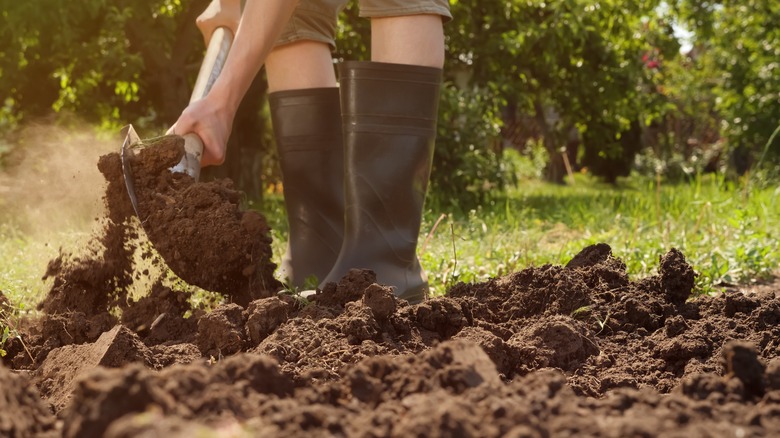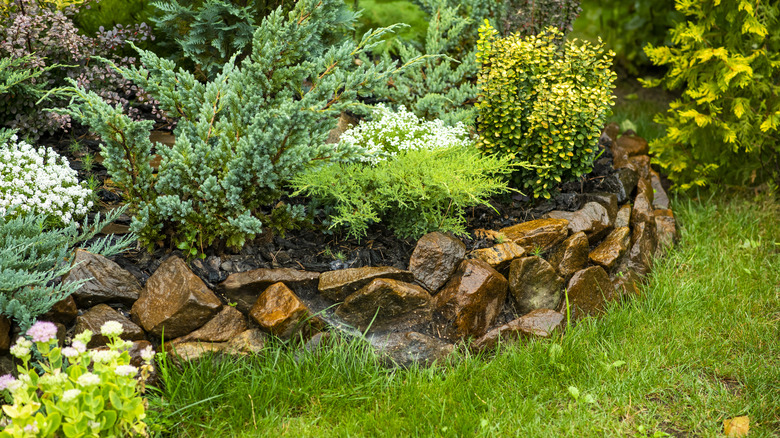Create A No-Dig Garden With This Clever Cardboard Box Hack
Creating a garden can feel like a daunting prospect. Digging out clumps of grass or weeds, loosening or tilling the soil, and shaping a new bed all add up to a lot of hard work. But there's an easy way to create a new garden without any digging. A clever hack using cardboard allows you to avoid all the effort normally associated with creating a new garden spot.
Referred to as "lasagna gardening" by many gardeners, this organic method involves using cardboard layered on top of the spot where you want to grow plants. This deprives the grassy, weedy growth of sunlight. Then you layer fresh soil, compost, and mulch on top, enclose them with stones or other barriers, and plant your plants as desired.
This practice is somewhat similar to the European technique known as "Hugelkultur," which involves creating a layered garden bed on top of old logs and wood, piling branches on top of logs, and covering it with compost and soil; once the wood begins to rot, the pile settles and provides a nutrient-rich growing medium. The cardboard method is much faster and, in many ways, easier than Hugelkultur, and you'll be able to get to planting almost immediately. There are a few tips to help you be successful with this easy garden hack.
Creating a lasagna garden
Choose a spot for your lasagna garden that is fairly level. Also, choose the right sun or shade environment for what you want to grow. For example, if you want to plant vegetables or perennial flowers, you'll most likely want a sunny spot. For a hosta bed, shade will do fine. Remove any rocks or other objects that might make bumps under the cardboard; you want it to lay as flat as possible on the ground.
Prepare the cardboard by breaking it down or cutting it to size. Don't use cardboard with plastic or wax coating. Also, remove any tape or staples, as you don't want these to end up in your garden bed. Lay down the cardboard and add your first layer of soil; feel free to add dried leaves and grass clippings mixed together. You can add compost and other soil amendments too. You can also do this same method with layers of newspaper or brown paper instead of cardboard. Experiment with what works: maybe a layer of cardboard, followed by soil, then newspaper, compost, and more soil.
Level out the surface and make sure the soil is deep enough for the roots of your plants. Shallow-rooted plants (like irises, heucheras, astilbes, or day lilies) work better for this type of garden than plants with deep tap roots (like Rose of Sharon or peonies).
Maintaining your lasagna garden
Add some kind of edging to keep the soil in one place. Bricks or stones work fine, and you can use salvaged materials such as cinderblocks. After you add plants, add enough soil to cover the roots to the proper depth. Add a layer of natural mulch (pine bark or wood chips). The mulch will help maintain moisture and deter weeds as your lasagna garden gets established. If you see any weeds poking through around the edges, remove them by digging them out by the roots (pulling them may leave all or part of the root intact).
You may find the grass or weeds will try to grow back, especially around the edges. You can try to widen the edges of your lasagna garden by adding more cardboard and repeating the process, layering with soil, compost, and mulch. Be sure to overlap the cardboard by placing it as close as possible to the first layer of cardboard, eliminating any spaces. You can also try adding wider or sturdier barriers to help control weeds on the edges. You can also place the barriers (such as bricks or pavers) on top of the cardboard for added sturdiness.
Over time your lasagna garden should behave like any other garden bed, though you may occasionally have to trim or control a bit of weedy growth around the edges. Add soil amendments and natural mulch every year or as needed.

